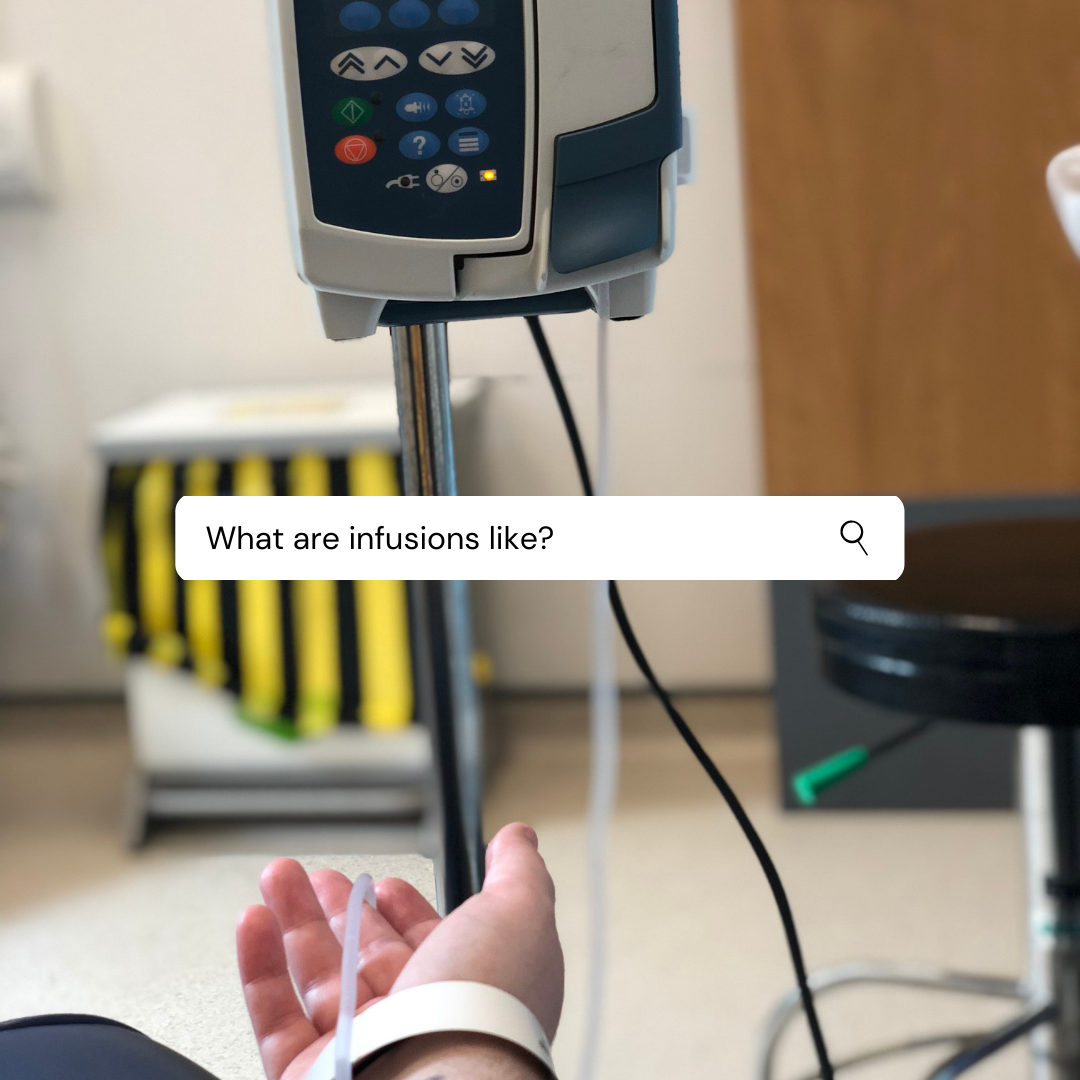
“What are infusions like?”
Intravenous simply means ‘into a vein’. Medicines and other fluids can be given directly via a vein into your bloodstream. A fine tube, called a cannula, is inserted into a vein, usually in your arm or hand, using a needle. The cannula is then connected by an IV line (a long, thin tube) to an infusion pump that delivers the medicine or fluid. Infusions are usually given by medical staff in a hospital or clinic.
Infusion medications for IBD may include the following:
- Cyclosporine (Gengraf®, Sandimmune®)
- Infliximab (Remicade®)
- Infliximab biosimiliars (Renflexis®, Inflectra™ & IXIFI™)
- Natalizumab (Tysabri®)
- Ustekinumab (Stelara®)
- Tacrolimus (Prograf®)
- Vedolizumab (Entyvio®)
What does having an infusion feel like?
Everyone is unique, experiencing pain and discomfort differently, so this is a difficult question to answer completely. People report varying levels of discomfort at having a cannula inserted into their vein, some experiencing little or no discomfort at all. Most people don’t feel anything when the medicine goes into their vein, although occasionally it can feel cool for a short time.
The build-up to, and worry about having, an infusion can often be worse than the actual infusion itself. On top of that you might be concerned about the time it takes to have an infusion, the need to take time off work or organise childcare. You may find it becomes easier after a few treatments, you are more familiar with the routine, and know what to expect. Hopefully, by then you will also be feeling better.
How should I prepare for an infusion?
If you feel unwell in the days leading up to your infusion, it is important you contact your IBD team for advice, as your infusion may need to be rescheduled.
When you go for your infusion:
- Allow plenty of time to get there!
- Try to drink plenty of water beforehand, and keep warm – this will help make it easier to find a vein when your cannula is inserted.
- You may want to bring a drink, a snack, and something to keep yourself entertained, as you can be there for several hours. You may want to bring a charger if you are planning to use an electronic device.
- It’s a good idea to dress comfortably, in clothes that allow easy access for inserting your cannula. Wear layers in case you feel too warm or too cool.
Before your infusion
- You will be asked if you are well, and whether you have any symptoms of infection. This is because biologic medicines can affect your immune system, and your infusion may need to be delayed until you are feeling better.
- You may be asked to provide a urine sample to check for infections.
- Your blood pressure, pulse rate and temperature will be taken. You may also be weighed.
- A cannula will be inserted into your arm or hand using a needle. This is secured with tape, and the needle removed. You’ll likely have the cannula flushed – a sample syringe of saline will be given through the cannula to check it’s working – and then a dressing will be placed over to keep it in place. The cannula will be used to deliver the infusion, and also to have a blood sample taken, if required.
- Your biologic medicine will be prepared once you are ready for your infusion. Medicines are not prepared in advance in case you are unable to have your infusion, resulting in expensive biologic medicines being wasted.
- You may want to go to the toilet before your infusion. Your infusion will usually be portable, which means that you can go to the toilet during your infusion if you need to.
- If required, you will be given your premedication via your cannula.
When it’s time for your infusion
- An IV line will be set up to connect the infusion pump to your cannula. It will deliver your biologic medicine at a constant rate over the period of time appropriate for you and the particular biologic you are being given.
- You will be monitored at regular intervals throughout your infusion.
- When your infusion is complete, you will continue to be monitored until medical staff are sure you haven’t reacted to the biologic medicine.
- If you have any questions or concerns about your infusion or begin to feel unwell during or just after your infusion, speak to the medical staff who are looking after you.
- That’s it, you can go home! Some people find they are happy to drive themselves home, however, some prefer to have someone collect them, especially at first.
Some people report feeling fatigued, nauseous and having headaches following an infusion, whilst others report no side effects at all. Most people will notice bruising and discomfort around the place where your cannula was inserted, but this should go away on its own.
NEW tips for receiving infusions in a outpatient setting:
- Call and confirm your appointment prior to your visit to ensure that they can still receive you.
- Ask about policies that may have changed regarding social distancing. Some infusion centres may be rescheduling patients or requiring new protective measures to adhere to national and local guidelines.
- Check with infusion staff about their check-in procedures.
- For example, you may be required to wait in your vehicle or outside the building to avoid gathering in a waiting room.
- Or you may be instructed to call from your mobile phone when you arrive.
- If you aren’t feeling well, always check with your IBD team BEFORE going to the infusion appointment.

Until next time,

Do you have any questions or queries? Or just want to share your own experiences? You can leave me a reply here or leave comments via my social media accounts – on Twitter, find my blog page on Facebook and over on Instagram
If you enjoyed this post check out “Does being in hospital get easier?” and Being [Unexpectedly] Medication Free for a Year.
References:
Crohns and Colitis UK – Infliximab – Vedolizumab
IBD Relief – Having biologic infusions for IBD
Crohns Colitis Foundation – Fact Sheet: Biologics



